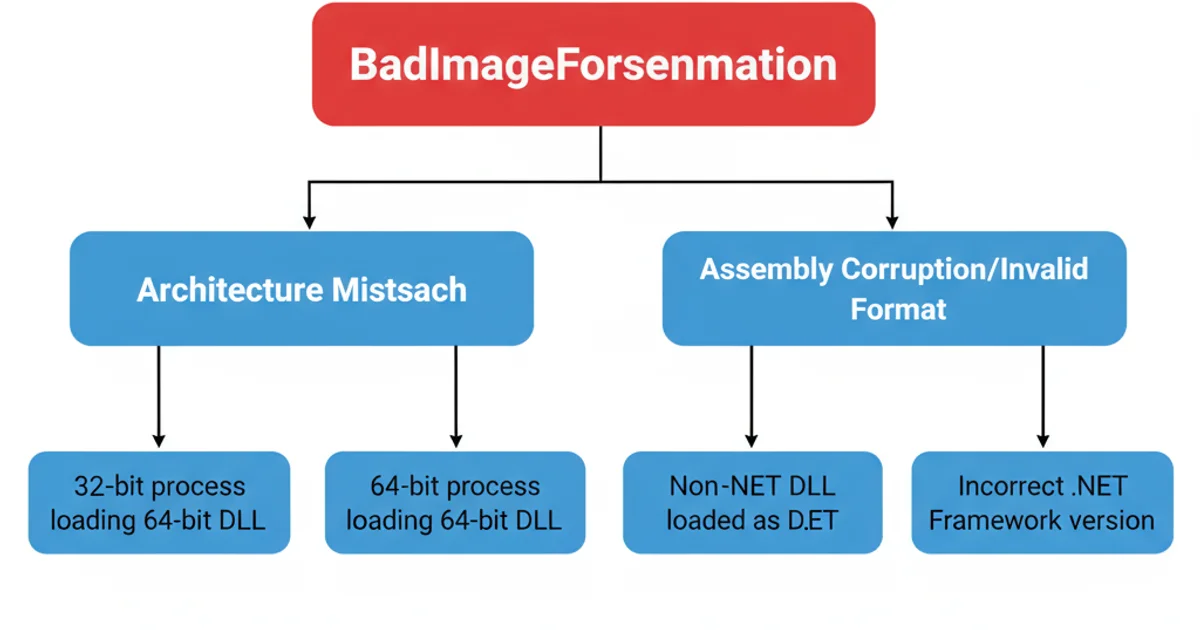BadImageFormatException was unhandled
Categories:
Resolving 'BadImageFormatException was unhandled' in .NET Applications

Understand and troubleshoot the 'BadImageFormatException' in C# and C++ .NET projects, often caused by architecture mismatches or corrupted assemblies.
The BadImageFormatException is a common and often perplexing error encountered by developers working with .NET applications, particularly in C# and C++ projects. This exception typically indicates that an attempt was made to load a file that is not a valid .NET assembly or that its format is incompatible with the currently executing environment. It's akin to trying to play a DVD in a CD player – the format simply doesn't match.
Understanding the Root Causes
The BadImageFormatException primarily arises from mismatches in processor architecture (32-bit vs. 64-bit) or issues with the assembly itself. Understanding these core reasons is crucial for effective troubleshooting.

Common causes of BadImageFormatException
Architecture Mismatch
This is by far the most frequent cause. It occurs when a .NET application compiled for one processor architecture (e.g., x86 for 32-bit) attempts to load an assembly compiled for a different architecture (e.g., x64 for 64-bit), or vice-versa. This is especially common when dealing with unmanaged C++ DLLs or third-party libraries that have specific architecture requirements.
Corrupted or Invalid Assembly
Less common but equally problematic, the exception can be thrown if the assembly file is corrupted, incomplete, or simply not a valid .NET assembly. This can happen due to download errors, disk corruption, or if you're trying to load a non-.NET DLL (like a native C++ DLL) using Assembly.Load methods designed for managed assemblies.
Troubleshooting Strategies
Resolving BadImageFormatException often involves systematically checking your project's build configurations and dependencies. Here are the primary steps to take.
1. Verify Project Platform Target
Ensure your main executable project and all dependent projects (especially those referencing problematic DLLs) are targeting the correct platform. In Visual Studio, right-click your project -> Properties -> Build -> Platform target. Options are 'Any CPU', 'x86', or 'x64'.
2. Inspect Dependent Assemblies
If you're referencing a third-party DLL, determine its architecture. Tools like dumpbin /headers (for native DLLs) or ildasm (for managed DLLs) can help. Ensure your project's platform target matches the architecture of the DLL you're trying to load.
3. Use 'Any CPU' with Caution
While 'Any CPU' is often a good default, it can lead to issues when mixed with architecture-specific dependencies. An 'Any CPU' application runs as 64-bit on a 64-bit OS and 32-bit on a 32-bit OS. If it then tries to load an x86-only DLL on a 64-bit OS, it will fail. In such cases, explicitly setting the platform target to 'x86' for your main project might be necessary.
4. Check for Corrupted Files
If architecture isn't the issue, try replacing the problematic DLL with a fresh copy. Rebuild your project and clean your solution to ensure no stale files are being used.
5. Verify .NET Framework Version
Ensure that all assemblies are built against compatible .NET Framework versions. While less common for BadImageFormatException, version mismatches can cause other loading issues.
BadImageFormatException will occur. In such scenarios, explicitly setting your project's platform target to 'x86' is often the solution.Example: Resolving an Architecture Mismatch
Consider a scenario where you have a C# application that needs to interact with a legacy C++ DLL compiled specifically for x86 (32-bit). If your C# project is set to 'Any CPU' and runs on a 64-bit machine, it will default to a 64-bit process, leading to the BadImageFormatException when trying to load the 32-bit C++ DLL.
using System;
using System.Runtime.InteropServices;
public class MyManagedApp
{
// This DllImport will fail if the C# app is 64-bit and MyLegacyCpp.dll is 32-bit
[DllImport("MyLegacyCpp.dll", EntryPoint = "AddNumbers")]
public static extern int AddNumbers(int a, int b);
public static void Main(string[] args)
{
try
{
Console.WriteLine("Attempting to call native DLL function...");
int result = AddNumbers(5, 7);
Console.WriteLine($"Result from native DLL: {result}");
}
catch (BadImageFormatException ex)
{
Console.WriteLine($"Caught BadImageFormatException: {ex.Message}");
Console.WriteLine("This often means an architecture mismatch (e.g., 64-bit app loading 32-bit DLL).");
Console.WriteLine("Consider setting your project's Platform target to x86.");
}
catch (Exception ex)
{
Console.WriteLine($"An unexpected error occurred: {ex.Message}");
}
}
}
C# code attempting to load a native DLL
To resolve this, you would change the C# project's platform target to 'x86':
- In Visual Studio, right-click your C# project in Solution Explorer.
- Select 'Properties'.
- Go to the 'Build' tab.
- Change the 'Platform target' dropdown from 'Any CPU' to 'x86'.
- Rebuild your project.